What is Israel’s Iron Dome defence system used against Iran’s drone and missile strikes and how does it work?
Israel faced a heavy bombardment from more than 300 drones and ballistic missiles on Saturday evening, in the latest challenge to the country’s ’90 percent effective’ missile-intercepting Iron Dome.
All but a few were intercepted by Israel and its allies, including Britain and the United States, officials said.
The powerful short-range defense system was used to shoot down the incoming barrage of drones, cruise missiles and rockets fired from Iran, Lebanon, Iraq and Yemen, and has also been working at full strength to deal with attacks during the six months long war. against Hamas.
The Iron Dome detects incoming missiles before determining its path and intercepting it, and has fired thousands of airborne weapons since it first entered service in 2011.
The three-part, billion-dollar air defense system, developed by Israel with US support after the 2006 Lebanon War, has been crucial in defending Israeli cities for more than a decade and is credited with preventing serious damage or casualties.
MailOnline took a look at the impressive system and how it works.
Israel’s Iron Dome uses advanced radar to detect incoming airborne objects such as drones, rockets and missiles
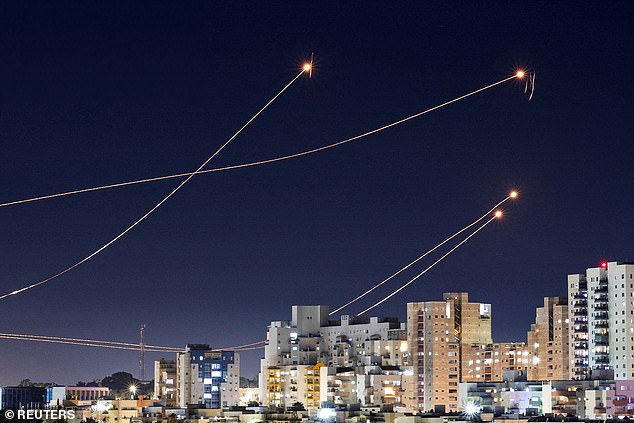
Israel’s Iron Dome anti-missile system intercepts rockets launched from the Gaza Strip in January 2024
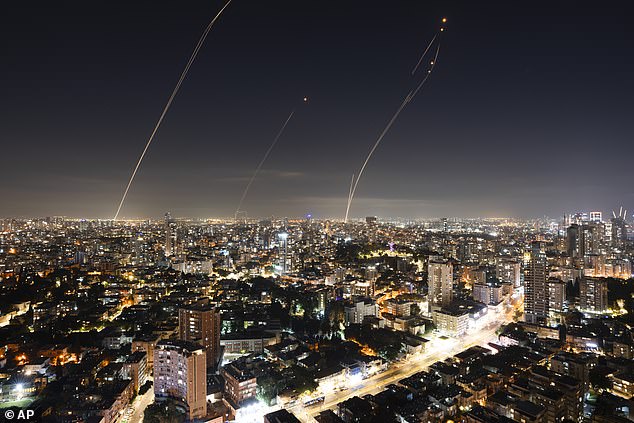
Israel’s Iron Dome air defense system fires to intercept a rocket fired from the Gaza Strip, in central Israel, in November 2023
What is the Iron Dome?
The Iron Dome is an all-weather mobile system in Israel consisting of at least ten missile defense batteries strategically located across the country.
The device consists of three main parts: a radar detection system, a computer that calculates the trajectory of the incoming missile, and a launcher that fires interceptors if the missile is deemed likely to hit a built-up or strategic area.
It uses advanced radar to detect incoming airborne objects such as drones, rockets and missiles and transmits the information back to a command and control center.
Here the threat is monitored to assess whether it is a false alarm and what the possible destination of the flying object is.
Each truck-towed unit then fires radar-guided missiles to blow up short-range threats such as rockets, mortars and drones in the air.
The system fires the interceptors – just 6 inches wide and 10 feet long – at the incoming threats most likely to hit a populated area.
Each Iron Dome battery consists of three to four launchers, each capable of carrying up to twenty Tamir interceptor missiles.
The batteries can neutralize threats launched up to 70 kilometers away, while simultaneously ignoring projectiles expected to hit unpopulated areas.
In late 2012, Israel said it hoped to increase the range of Iron Dome’s interceptions, from a maximum of 70 to 250 kilometers away, and make it more versatile so it could intercept missiles coming from two directions at once.
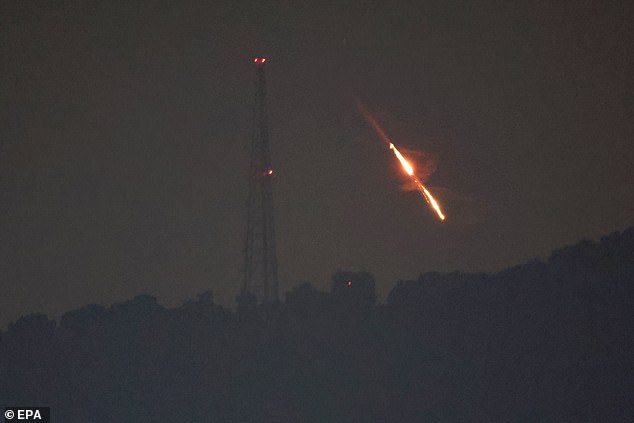
A view shows drones or missiles battling for targets in secret locations in northern Israel
The ten Iron Domes deployed across the country are capable of defending nearly 100 square kilometers of land, protecting countless civilians and critical infrastructure.
The system was developed by state-owned Rafael Advanced Defense Systems and Israel Aerospace Industries and was upgraded in 2012, but details of the changes were not made public.
The United States supported the original project in 2006 with a $200,000 grant.
The Iron Dome is just one of Israel’s three-tiered missile defense systems, along with The Arrow and David’s Sling.
The Arrow system, co-developed with the US, is designed to intercept long-range missiles, including the types of ballistic missiles Iran said it launched on Saturday.
The Arrow, which operates outside the atmosphere, has been used in the current war to intercept long-range missiles launched by Houthi militants in Yemen.
David’s Sling, also developed in collaboration with the US, is intended to intercept medium-range missiles, such as those launched by Hezbollah in Lebanon.
How effective is the Iron Dome?
Iron Dome’s effectiveness has improved since it first successfully disabled an enemy projective in April 2011, achieving a success rate of approximately 90 percent, according to Rafael Advanced Defense Systems.
In Saturday night’s attack, most of the roughly 300 rockets were intercepted by the defense arm before reaching Israeli territory, while others were shot down by the United States and other allies.
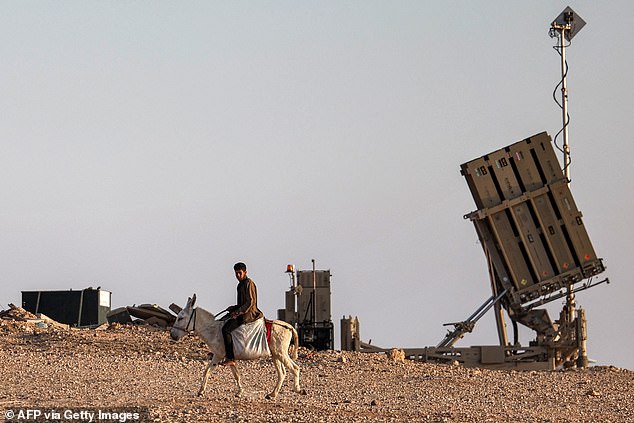
A complete battery is estimated to cost £80 million to produce, while each interceptor costs up to around £40,000 to launch
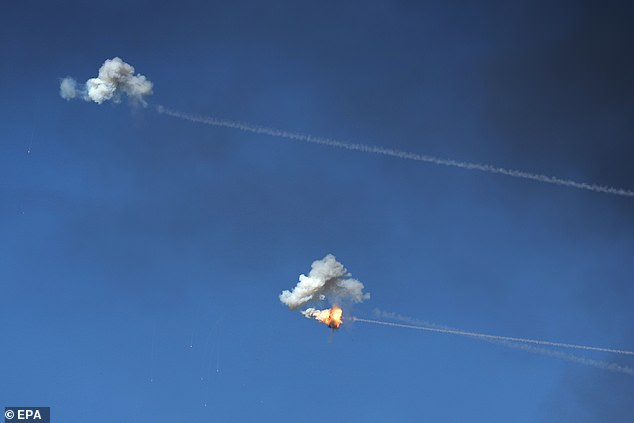
Israel’s Iron Dome air defense system intercepts a missile launched from the Gaza Strip towards southern Israel, January 21, 2024
It has also proven to be highly effective in recent years, with its capabilities particularly highlighted in 2021 after militant groups in Gaza fired at least 4,000 rockets during the May 11-day war.
In the first 24 hours of the conflict, 470 rockets were fired with the Iron Dome system intercepting approximately 90% of the rockets heading towards populated areas in Israel.
In the US, Lieutenant General Henry A. Obering wrote in Defense News: ‘Iron Dome has stopped more than 2,000 missiles fired at Israeli population centers with a remarkable success rate, an achievement that has also changed US thinking about missile defense in the changed his own country.
‘Iron Dome is the most proven and affordable option against fire at a very short distance.’
He called it a “game changer.”
On the battlefield during Operation Pillar of Defense in November 2012 and when used during Operation Protective Edge in 2014, the system had a success rate of 84 percent and 91 percent, respectively.
But things become more complicated when the drones fly so low that radar can’t detect them.
Israel has hundreds of interceptor missiles, but the Iron Dome is under enormous pressure, as seen on October 7, when Hamas attacked Israel with a barrage of thousands of missiles.
Hamas said it launched 5,000 rockets in the first attack and the Israeli military responded by saying only 2,500 rockets were fired.
“That amount was simply too much for Iron Dome,” the Modern War Institute report said.
This suggests that the Iron Dome has a limit to the number of missiles it can intercept, and if that number is exceeded, the rest of the missiles will enter the system, according to a Forbes 2021 report.
Just two days after the October 7 massacre, the Israeli government asked the US for more precision-guided munitions for its fighter jets and more interceptors for its Iron Dome missile defense system, a US official said.
How much is it?
According to the Institute for National Security Studies, a Tel Aviv-based think tank, a complete battery costs an estimated £80 million to produce, while each interceptor costs up to around £40,000 to launch.
The US has invested heavily in the system, helping with development costs and supplementing the system in times of conflict.
According to the Congressional Research Service, the US has allocated nearly nine billion pounds to Israeli missile defense systems since 1946, including nearly two billion pounds for the Iron Dome.

Iron Dome anti-missile defense system deployed near Jerusalem, April 14, 2024
US President Joe Biden has said he will ask Congress for £11.4 billion in military aid for Israel – which the White House said would help with air and missile defense systems such as the Iron Dome.
“We are deploying additional military assistance, including munitions and interceptors to replenish Iron Dome,” Biden said.
The future of the Iron Dome
Rafael says it delivered two Iron Dome batteries to the US military in 2020, but the US isn’t the only country eager to get its hands on the high-powered batteries.
Last year, Ukraine asked Israel for an Iron Dome system and other air defense equipment to defend against Iranian ballistic missiles and attack drones used by Russia in its ongoing invasion.
Israeli Prime Minister Benjamin Netanyahu said earlier this year that he supports Ukraine but ruled out sending Kiev an Iron Dome system over concerns that Iran could obtain it, which would seriously endanger Israel’s security.
Several other countries have also shown interest in purchasing Iron Dome systems in recent years, including Germany, Romania and India.
In 2017, a naval version of the Iron Dome was also deployed to protect ships and assets at sea.
